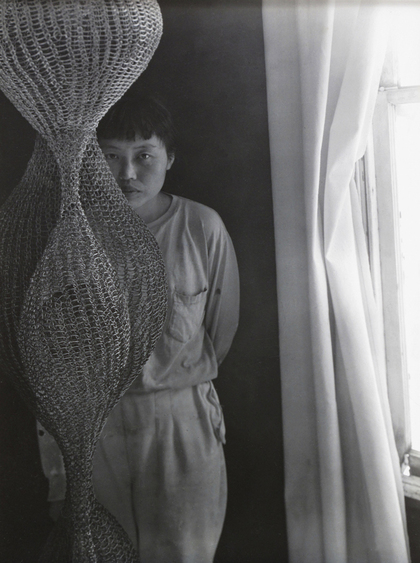Ruth Asawa: 1926–2013
By Hanae Ko

Portrait of Ruth Aiko Asawa. Courtesy Christie
Ruth Aiko Asawa, a modernist sculptor and arts education advocate, known for weaving wire into intricate, abstract sculptures, died on August 6 at the age of 87.
Born in 1926 to a Japanese-American family, in the Southern Californian farming town of Norwalk, Asawa’s interest in art began at an early age. Her third-grade teacher first encouraged her artistic leanings, which Asawa pursued through her teenage years. In 1942, at the height of the Second World War, her family, along with 120,000 other Japanese-Americans, was sent to an internment camp. The Asawas spent the first six months of detention in horse stables at the Santa Anita Park racetrack in Los Angeles.
Later relocated to an internment camp in Arkansas, Asawa eventually graduated from high school there. In 1943, with the help of a charitable Quaker organization, she went on to attend the Milwaukee State Teachers College (now University of Wisconsin-Milwaukee) to become an art teacher. Upon completing the three-year program, however, she was barred from taking a required student-teacher program due to her Japanese heritage and was therefore unable to earn her degree. Undeterred, Asawa spent another three years at Black Mountain College, an experimental art school in North Carolina, where she studied under avant-garde painter Josef Albers. There she met her future husband, the architect Albert Lanier, with whom she moved to San Francisco in 1949.
Following a memorable trip to Mexico in 1947, Asawa began experimenting with wire as an artistic medium. Inspired by the looped wire baskets used to sell produce in Mexican markets, she created abstract crocheted sculptures, developing elements that would become her signature style. Elaborating on this wire-based work, Asawa reflected, “I was interested in it because of the economy of a line, making something in space, enclosing it without blocking it out. It’s still transparent. I realized that if I was going to make these forms, which interlock and interweave, it can only be done with a line because a line can go anywhere.” Her wire sculptures received international recognition in the 1950s and ʼ60s, when they were shown in multiple exhibitions at New Yorkʼs Whitney Museum of American Art, as well as at the 1955 São Paulo Art Biennial.
Admirers of Asawa’s work were surprised when, in 1968, she created her first representational work—a sculptural fountain in San Franciscoʼs Ghirardelli Square, which still stands today. The fountain features two mermaids, some turtles and frogs, as well as a sound recording of the amphibians croaking. Following this project, Asawa went on to design several other public fountains in San Francisco, acquiring the nickname “fountain lady” within the local community.
In 1973, another of Asawa’s sculptural fountains was unveiled at the plaza of the Grand Hyatt hotel near Union Square in San Francisco. For this sculpture, she had 250 schoolchildren and friends mould hundreds of figures, inspired by the city, in dough which were then cast in bronze. This past summer, the work became embroiled in a controversial dispute when Apple Inc. revealed its plans to move the fountain in order to make way for a plaza adjoining its new store location. Following a public outcry, Apple and city officials promised to preserve Asawaʼs sculpture, though the final fate of the work remains undecided.
As evidenced in her artistic collaboration with schoolchildren, Asawa was a strong supporter of arts education. In 1968, she cofounded the Alvarado School Arts Workshop, an innovative program that engaged parents and professional artists in teaching art to children in public schools. Around this time, Asawa also became a member of the San Francisco Arts Commission and lobbied politicians and charities to support public arts programs that would benefit children and citizens of San Francisco. At its peak, the Alvarado School Arts Workshop was in 50 local public schools and involved numerous artists, musicians and gardeners. From 1989 to 1997, Asawa was also a trustee of San Franciscoʼs Fine Arts Museums, where she supported the Museums’ school art programs. A public arts high school that the artist helped to establish in 1982 was renamed the Ruth Asawa San Francisco School of the Arts in 2010, in honor of her tireless dedication to the cause.
1998 was a turning point for Asawa’s own educational experience. The University of Wisconsin-Milwaukee—which had prevented her from graduating half a century earlier—sought to present Asawa with an honorary doctorate. At the artist's request, Asawa was finally awarded a bachelor’s degree.
Today, Asawa’s ethereal wire sculptures are in the permanent collections of the Solomon R. Guggenheim Museum and the Whitney Museum of American Art in New York. In 2005, when the de Young Museum in San Francisco inaugurated its new building, 15 of her most prominent wire sculptures—seminal works from the 1950s and ʼ60s—resembling an eerie, kelp forest, were installed at the site. This past spring, one of Asawaʼs largest copper-and-brass wire weavings, entitled Untitled (hanging, six lobed, multi-layered continuous form within a form) (c. 1960s), sold for USD 1.4 million at Christieʼs New York—a testament to the ever-growing appreciation of her work.
The Fine Arts Museum in San Francisco, which had a longstanding relationship with Asawa, holds more than 150 of her works in its collection. Board president Diane B. Wilsey commemorated the artist’s numerous contributions to the museum: “Not only was she a loyal trustee, dedicated to the successful completion of the new de Young Museum, but she was also truly the heart of our board and a source of great personal encouragement during those challenging and exciting years.” A memorial celebrating the life of the artist was held on August 27, at the Music Concourse Band Shell in San Francisco's Golden Gate Park.






